Photonics for Agri-Food
Topic Leader: Giovanni Agati
IFAC has long been engaged in research applied to the agri-food sector, with competence relevant to the development of new photonics methods and tools for innovative Green Analytical Chemistry. In particular, the BioPhotonics and Nanomedicine Lab is dedicated to the application of portable fluorometers for the non-destructive detection of leaves and fruits phytochemicals whose spatial variability is studied by geostatistics and mapping.
Fluorescence spectroscopy techniques have been developed to study in situ anthocyanin derivatives indicators of wine aging.
Fluorescence optical sensors for mapping
Wine grape and table grape maturity
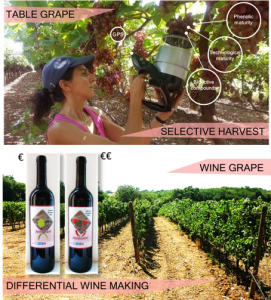 Non-destructive mapping of anthocyanins can be performed in the vineyard by using a fluorescence optical sensor. It is based on the measurement of grape berry chlorophyll fluorescence at different excitation wavelengths, more or less absorbed by pigments present on the berry external layers.
Non-destructive mapping of anthocyanins can be performed in the vineyard by using a fluorescence optical sensor. It is based on the measurement of grape berry chlorophyll fluorescence at different excitation wavelengths, more or less absorbed by pigments present on the berry external layers.
Once the anthocyanins optical index has been calibrated against wet chemistry, it can be used to report the spatial heterogeneity of anthocyanins concentration in the vineyard.
This technique allows for vineyard zoning to perform a selective harvest and consequently in grape wine a separated vinification to produce high quality wines.
For more info please contact Giovanni Agati
Main references:
- Tuccio, L., Cavigli, L., Rossi, F., Dichala, O., Katsogiannos, F., Kalfas, I., & Agati, G. (2020). Fluorescence-sensor mapping for the in vineyard non-destructive assessment of crimson seedless table grape quality. Sensors, 20(4), 983. https://doi.org/10.3390/s20040983
- Agati, G., Soudani, K., Tuccio, L., Fierini, E., Ben Ghozlen, N., Fadaili, E. M., … & Cerovic, Z. G. (2018). Management Zone Delineation for Winegrape Selective Harvesting Based on Fluorescence-Sensor Mapping of Grape Skin Anthocyanins. Journal of agricultural and food chemistry, 66(23), 5778-5789. https://doi.org/10.1021/acs.jafc.8b01326
- Patrizia Pinelli, Annalisa Romani, Elisa Fierini, Giovanni Agati (2018). Prediction models for assessing anthocyanins in grape berries by fluorescence sensors: Dependence on cultivar, site and growing season. Food Chemistry 244, 213-223. https://doi.org/10.1016/j.foodchem.2017.10.021
- Alessandra Ferrandino, Chiara Pagliarani, Antonio Carlomagno, Vittorino Novello, Andrea Schubert and Giovanni Agati (2017). Improved fluorescence-based evaluation of flavonoids in red and white wine-grape varieties. Australian Journal of Grape and Wine Research 23, 207–214. https://doi.org/10.1111/ajgw.12276
- Tuccio, L., Agati, G., & Grassini, G. (2015, May). Non-destructive fluorescence sensing for applications in precision viticulture. In 2015 International Conference on BioPhotonics (BioPhotonics) (pp. 1-4). https://doi.org/10.1109/BioPhotonics.2015.7304031
- Agati, G., D’Onofrio, C., Ducci, E., Cuzzola, A., Remorini, D., Tuccio, L., … & Mattii, G. (2013). Potential of a multiparametric optical sensor for determining in situ the maturity components of red and white Vitis vinifera wine grapes. Journal of agricultural and food chemistry, 61(50), 12211-12218. https://doi.org/10.1021/jf405099n
- Tuccio, L., Remorini, D., Pinelli, P., Fierini, E., Tonutti, P., Scalabrelli, G., & Agati, G. (2011). Rapid and non‐destructive method to assess in the vineyard grape berry anthocyanins under different seasonal and water conditions. Australian Journal of Grape and Wine Research, 17(2), 181-189. https://doi.org/10.1111/j.1755-0238.2011.00139.x
- Agati, G., Mattii, G. B., Tuccio, L., Remorini, D., Tonutti, P., & Scalabrelli, G. (2009). Non destructive in vineyard monitoring of winegrape phenolic maturity using a portable fluorescence sensor. In 5th International Specialized Conference On Sustainable Viticulture: Winery Waste and Ecologic Impacts Management-Winery 2009. (pp. 455-458). Eds. F. Cecchi, M. Greven, S. Minguez, P. Foladori, D. Bolzonella, Università degli Studi di Trento.
Shading effect on coffee quality
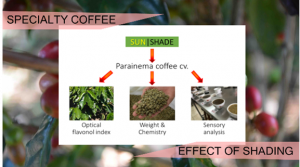 Non-destructive mapping of leaf flavonols can be performed to assess the cumulative sunlight effect on plants by using a leaf flavonols optical index. This technique allows to quantify the spatial variability of shading.
Non-destructive mapping of leaf flavonols can be performed to assess the cumulative sunlight effect on plants by using a leaf flavonols optical index. This technique allows to quantify the spatial variability of shading.
It was used in ‘specialty’ coffee production to perform the zoning of plantations and the selective harvest of coffee beans from shaded and full sunlight plants to improve the coffee quality.
For more info please contact Lorenza Tuccio
Main references:
- Tuccio, L., Pinelli, P., Godina, A., Medina, J. M., & Agati, G. (2019). The chemical composition and quality of the Parainema coffee cultivar under different shading conditions, as assessed by a leaf flavonol optical index. European Food Research and Technology, 245(8), 1733-1741. https://doi.org/10.1007/s00217-019-03285-1
Leaf nitrogen content for precision fertilization
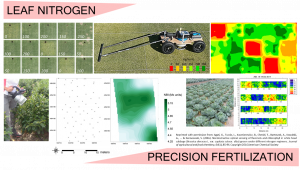 Non-destructive mapping of the leaf nitrogen content by the Nitrogen Balance Index as ratio of the chlorophyll and flavonols indices, allowing an earlier and more pertinent information about the nitrogen status of crops.
Non-destructive mapping of the leaf nitrogen content by the Nitrogen Balance Index as ratio of the chlorophyll and flavonols indices, allowing an earlier and more pertinent information about the nitrogen status of crops.
The interest is both economic and environmental:
- limit nitrogen applications to real plant needs
- reduce cost for fertilizers and nitrogen-related pollution
For more info please contact Giovanni Agati
Main references:
- Agati, G., Tuccio, L., Kusznierewicz, B., Chmiel, T., Bartoszek, A., Kowalski, A., … & Kaniszewski, S. (2016). Nondestructive optical sensing of flavonols and chlorophyll in white head cabbage (Brassica oleracea L. var. capitata subvar. alba) grown under different nitrogen regimens. Journal of agricultural and food chemistry, 64(1), 85-94. https://doi.org/10.1021/acs.jafc.5b04962
- Agati, G., Foschi, L., Grossi, N., & Volterrani, M. (2015). In field non-invasive sensing of the nitrogen status in hybrid bermudagrass (Cynodon dactylon× C. transvaalensis Burtt Davy) by a fluorescence-based method. European Journal of Agronomy, 63, 89-96. https://doi.org/10.1016/j.eja.2014.11.007
Reflectance optical sensor
Tomato lycopene assessment
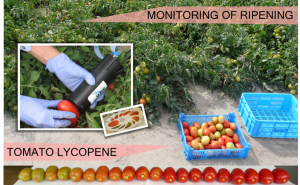 The lycopene content of tomato can be non-destructively assessed by reflectance spectroscopy, even in the field. A compact, low-cost, light emitting diode-based sensor was developed to measure reflectance in the 400–750 nm spectral range. Once calibrated against wet chemistry and evaluated by partial least squares (PLS) regression analyses, it can be used to optimize the date of harvest and obtain the maximum level of lycopene, to compare different varieties, to follow the ripening process from the field to the storage.
The lycopene content of tomato can be non-destructively assessed by reflectance spectroscopy, even in the field. A compact, low-cost, light emitting diode-based sensor was developed to measure reflectance in the 400–750 nm spectral range. Once calibrated against wet chemistry and evaluated by partial least squares (PLS) regression analyses, it can be used to optimize the date of harvest and obtain the maximum level of lycopene, to compare different varieties, to follow the ripening process from the field to the storage.
For more info please contact Giovanni Agati
Main references:
- Ciaccheri, L., Tuccio, L., Mencaglia, A. A., Mignani, A. G., Hallmann, E., Sikorska-Zimny, K., … & Agati, G. (2018). Directional versus total reflectance spectroscopy for the in situ determination of lycopene in tomato fruits. Journal of Food Composition and Analysis, 71, 65-71. https://doi.org/10.1016/j.jfca.2018.01.023
- Mignani, A. G., Ciaccheri, L., Mencaglia, A. A., Tuccio, L., & Agati, G. (2015, May). Application of a LED-based reflectance sensor for the assessing in situ the lycopene content of tomatoes (Lycopersicon esculentum Mill.). In Sensing for Agriculture and Food Quality and Safety VII (Vol. 9488, p. 948806). International Society for Optics and Photonics. https://doi.org/10.1117/12.2177896
- Sikorska‐Zimny, K., Badełek, E., Grzegorzewska, M., Ciecierska, A., Kowalski, A., Kosson, R., … & Agati, G. (2019). Comparison of lycopene changes between open‐field processing and fresh market tomatoes during ripening and post‐harvest storage by using a non‐destructive reflectance sensor. Journal of the Science of Food and Agriculture, 99(6), 2763-2774. https://doi.org/10.1002/jsfa.9484
- Ciaccheri, L., Tuccio, L., Mencaglia, A. A., Sikorska-Zimny, K., Hallmann, E., Kowalski, A., … & Agati, G. (2018). Prediction models for assessing lycopene in open-field cultivated tomatoes by means of a portable reflectance sensor: cultivar and growing-season effects. Journal of agricultural and food chemistry, 66(18), 4748-4757. https://doi.org/10.1021/acs.jafc.8b01570
Fluorescence wide-field and confocal microscopy localization
Polyphenols detection in plant tissues
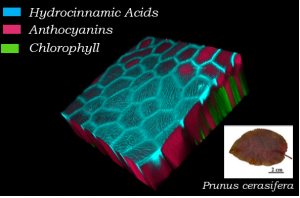 Multispectral fluorescence microimaging and microspectrofluorimetry represent useful tools to localize polyphenolic compounds in plant tissues. UV-excited blue autofluorescence can be used as proxy of hydroxycinnamic acids, while flavonoids can be detected as yellow fluorescence under blue excitation, once treated the sample with a specific fluorescence enhancer.
Multispectral fluorescence microimaging and microspectrofluorimetry represent useful tools to localize polyphenolic compounds in plant tissues. UV-excited blue autofluorescence can be used as proxy of hydroxycinnamic acids, while flavonoids can be detected as yellow fluorescence under blue excitation, once treated the sample with a specific fluorescence enhancer.
The information obtained are fundamental in eco-physiology studies to elucidate and understand the multifunctional role covered by these compounds in plants under different environmental conditions.
For more info please contact Giovanni Agati
Main references:
- Massimiliano Tattini; Martina Di Ferdinando; Cecilia Brunetti; Andrea Goti; Susanna Pollastri; Chandra Bellasio; Cristiana Giordano; Alessio Fini; Giovanni Agati (2014). Esculetin and esculin (esculetin 6-O-glucoside) occur as inclusions and are differentially distributed in the vacuole of palisade cells in Fraxinus ornus leaves: a fluorescence microscopy analysis. Journal of Photochemistry and Photobiology B: Biology 140: 28-35. https://doi.org/10.1016/j.jphotobiol.2014.06.012
- Agati, P. Matteini, A. Goti & M.Tattini (2007). Chloroplast-located flavonoids can scavenge singlet oxygen. New Phytologist 174: 77–89. https://doi.org/10.1111/j.1469-8137.2007.01986.x
Current members:
- Giovanni Agati (topic leader)
- Lucia Cavigli
- Carmelo Distefano
- Paolo Matteini
- Filippo Micheletti
- Francesca Rossi
- Francesca Sanfilippo
- Lorenza Tuccio
